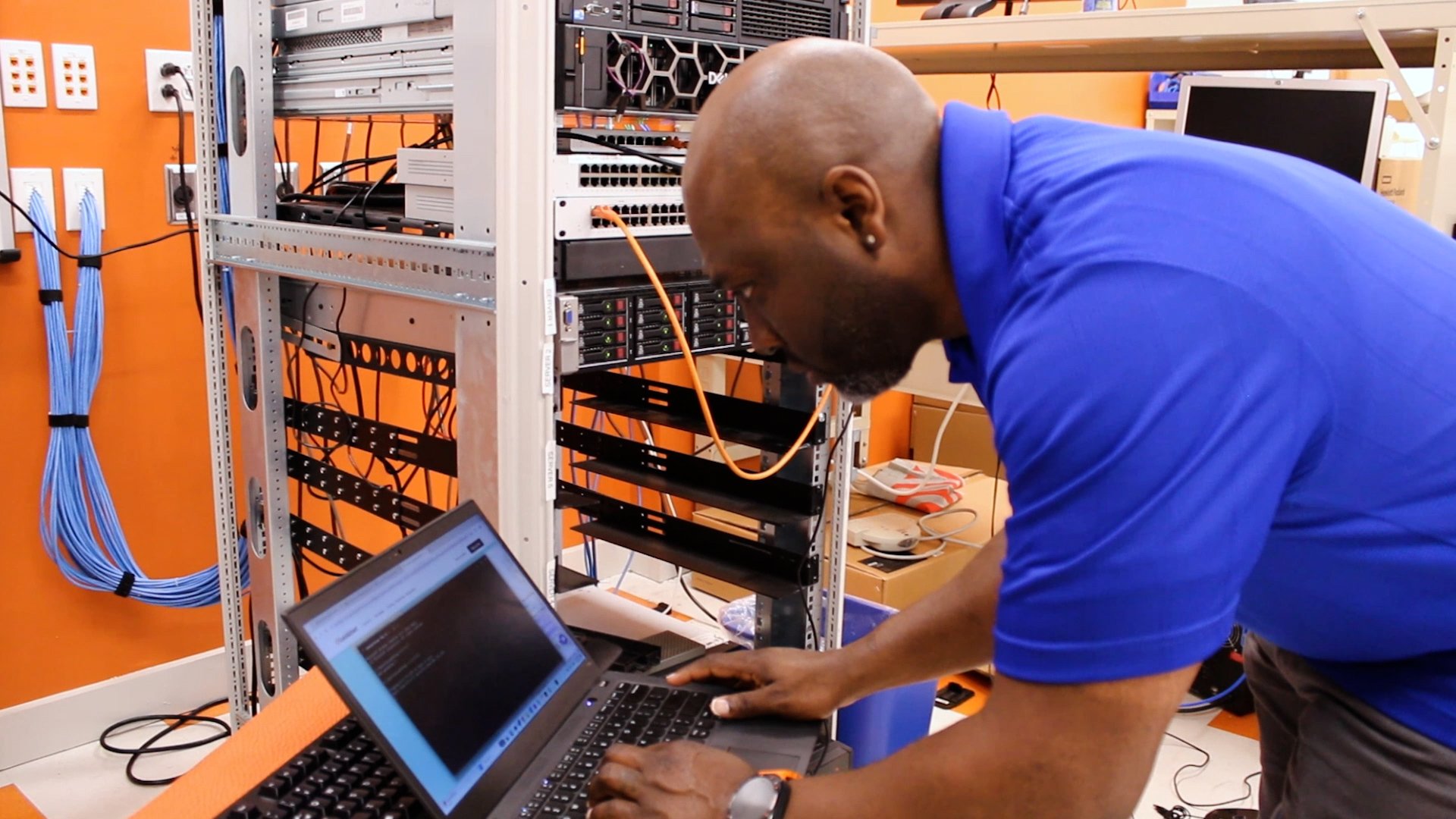How Can Cable Management Enhance IT Security & Business Efficiency?
An often overlooked part of a company’s IT performance and security is management of the data and power cables that enable its technology infrastructure.
You may be thinking that developing a cable management system is the last thing you need to worry about, or that it's simply a cosmetic concern.
But what happens if someone trips over a taut network cable and disconnects it, kicking your systems offline? What if your tangled and bent cables are actually slowing down file transfers, internet speeds, and routine business tasks?
Although cable management may seem like a low priority, keeping your cabling organized and in good condition is crucial to the performance of your business technology and data integrity.
In this article, we’ll explain what cable management is and why it’s an essential part of your business operations. With this information, you’ll know what you need to do to get your IT cables in order so your business can run efficiently and securely well into the future.
What Is IT Cable Management For Businesses?
Cable management often suffers from a classic case of “out of sight, out of mind.” After all, most of your company’s IT cabling is hidden behind ceiling tiles or tucked away in your on-premises server room or network center.
The cabling built into the building is called “structured cabling,” and its installation and organization is governed by a strict set of norms and standards. In environments such as municipal or medical settings, for instance, these standards are even stricter and possibly subject to compliance oversight.
Over time, the cabling can become disorganized, however, such as when new equipment is introduced.
If you stop to think about it, you have miles of cables coursing through your office or facility linking your infrastructure.
These cables directly link network equipment like routers, switches, firewalls, phone trunks, modems or optical transceivers (devices that send and receive data over fiber optic cables). Other parts of your IT environment also depend on them, including storage arrays, servers, desktops, laptops, phones, printers, credit card terminals, and peripherals of all kinds.
In addition, network cabling carries more than just Ethernet data. It powers your security cameras and provides a medium for audio/visual connections and projectors. Twisted pair cabling is also used for phones, embedded devices, industrial controls, and fire alarms.
Since cabling can be "invisible," it often takes a back seat to more prominent issues. Sometimes businesses aren't even aware of or don’t know how to identify cabling as the root cause of performance problems.
With that said, cable chaos doesn’t just impact network performance. It makes it more difficult and expensive to perform routine maintenance and react to emergencies.
What Problems Can A Lack Of IT Cable Management Cause Businesses?
Given the many parts of your environment that rely on cables, a lack of cable management can lead to various issues that can directly impact your business operations.
As we mentioned, introducing new devices into your legacy equipment environment can often exacerbate the problem.
Problems that can result from poor cable management include:
1. Delayed IT Troubleshooting and Response Times
- Cable clutter can delay your internal or external IT staff in troubleshooting a routine issue or even a critical work stoppage.
- Slow remediation efforts can cost you a lot of time and money. Your IT technicians may first have to unscramble your cables just to address the original problem. Once the problem is fixed, they then have to try to put everything back together without causing other issues.
2. Reduced Efficiency
- Loose, bent, badly terminated, or kinked Ethernet cables, and especially optical media (fiber) can cause signal loss and interference. This results in slower speeds along with trouble accessing resources, file sharing, and communications. Sometimes this will present as intermittent connectivity.
- Decreased productivity and operational efficiency could cause revenue losses due to project timeline delays, missed deadlines, or lost business opportunities. At best, cabling issues create frustrated users who can’t perform their work, and IT staff who face additional maintenance roadblocks.
3. Physical Safety
- Poorly managed cables can also create a tripping hazard and jeopardize the physical safety of your staff, or present obstacles for external vendors and contractors who need regular access to your equipment.
- Cables can get stepped on or accidentally pulled, becoming crushed or frayed and leading to possible disruptions and even operational downtime.
- Such physical workplace hazards may also violate state and federal safety regulations, including Occupational Safety & Health Administration (OSHA).
4. Power Failure/Fire
- If your PoE (Power over Ethernet) cables are damaged, it could lead to shorting, causing an electrical fire, power failure, or data or device loss.
- If the wrong type of cable sheathing is used in your building you may be unknowingly violating fire codes, and working around a dangerous smoke inhalation hazard.
5. Scalability Concerns
- Cable disorganization can significantly hurt your ability to scale your business in the future when you need to upgrade or add on new hardware.
- This can hold you back when you need to adapt to changing market conditions or to grow your business to gain a competitive advantage.
6. Data Loss
- Data loss is a possible risk when secure backups are not being used, or because backup and replication jobs are failing due to poor connectivity.
What Are Best Practices For Cable Management?
There are several steps you can take to make sure that the cables running through your physical environment are adequately organized and protected.
Cable management best practices:
1. Inventory and map your environment
Inventory your IT hardware and map out your physical environment. Your audit should include diagrams of where your IT is located within your building and any areas that are restricted to authorized users, such as your server room or data center.
2. Adopt a structured cabling system
Implement structured cabling to develop a plan and optimally organize the cables within your building.
Your system should use standard components, establish a central distribution point, determine horizontal and vertical pathways, and allow for future changes for improved scalability.
This will allow you to establish a well-defined, flexible layout that is tailored to your business. It will also ensure that you’re following industry best practices and regulatory guidelines.
3. Use labels, color-coding
Attach labels on either end of the cable, with detailed information about the use and function of the cables. This can be invaluable to your internal IT team or IT services provider when troubleshooting an issue.
At the same time, using a specific color-coding system can both simplify and speed up the process of diagnosing and correcting issues.
4. Implement physical protections
Use climate control systems to stabilize air temperatures and humidity levels, water leak sensors, surge protectors, uninterruptible power supply, smoke detectors, and fire extinguishers within the space to further protect both your cables and the devices they connect.
You should also routinely clean and dust your equipment and the areas surrounding it to help create proper air flow and keep them functioning at peak performance.
5. Create a safe working environment
By decluttering your cables, you create safe working conditions for your staff, contractors, and external partners. This will allow them to do their jobs better so they can quickly respond to issues, limiting disruptions and downtime.
The Bottom Line: Cable Management As A Core Component Of IT Security
How long could your business survive a prolonged disruption? A few days? A few hours?
Today’s tech-driven business landscape means businesses are more reliant than ever on their technology staying up and running efficiently and securely.
After reading this article, you now understand how something as seemingly inconsequential as cable management could cause major headaches if not sufficiently addressed.
While we know that managed IT support isn’t the right fit for every business, if you don’t have the internal IT staff to organize your IT cables, an IT services provider can help.
As a local managed IT services provider serving Connecticut, Massachusetts, and surrounding areas, at Kelser, we have decades of experience helping small and medium-sized businesses optimize their IT environment to boost network performance and reliability.
If you need help establishing an effective cable management solution, or you have other IT needs, click the button to contact us. We’re here to help.




